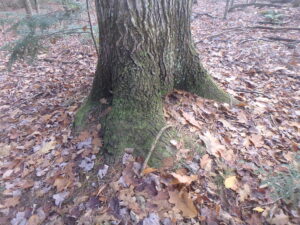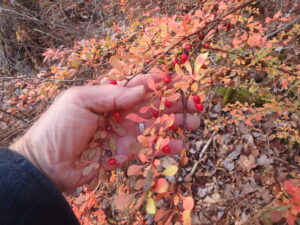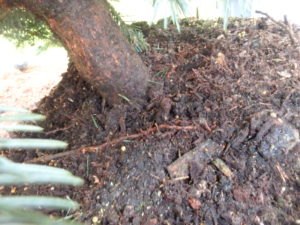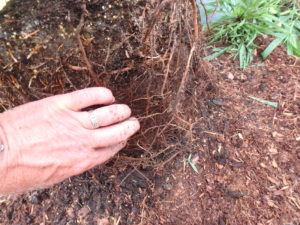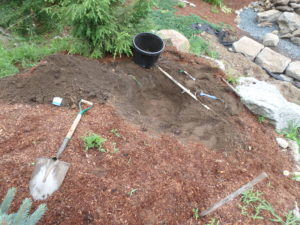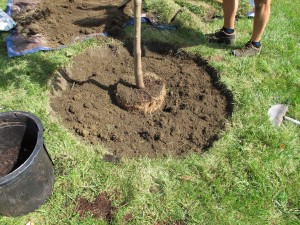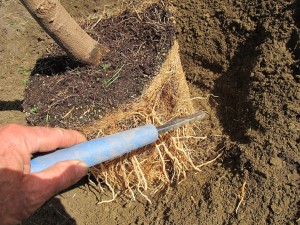Late Fall Chores in the Garden
If you planted trees in the past few years, you should look at them carefully. Most planting tags on purchased trees tell you to plant them at the depth they are in the pot. Unfortunately, many trees are grown on huge farms and slapped into pots without regard to the “trunk flare” – that part of the tree that should be above ground.
I was visiting long-time friends in Ohio recently, and they had 3 Fothergilla shrubs that had been in the ground 5 years and done almost nothing. I took a garden fork, thrust it into the soil nearby and tipped it back. Out popped the root ball – as if it had been planted the day before. I picked it up and took a look. Clearly the shrub had been in a one-gallon pot for a long time before they planted it. The roots had grown around and around the pot, keeping them from extending out into neighboring soil for moisture and minerals.
This is a good time to dig out invasive shrubs like burning bush or barberry that have been planted by birds. Their distinctive leaf color will help you find them now in your woods.
Tips on How to Plant a Tree Properly
I recently planted a couple of blue spruce trees on a nice cloudy day, and want to share with you what I did. First, and most important, I checked the position of the trunk of the tree in the pot. In the wild you will notice that trees bulge out at the base, creating what is termed the “trunk flare”. This must be visible above ground after planting.
Too often trees purchased at a nursery have the trunk flare covered with soil in the pot. Little seedlings are plucked from the ground and popped into pots without paying attention to the trunk flare. But, if the trunk flare and the bottom of the trunk itself is buried, the tree will not thrive or survive.
Why is this so important? Because unlike the roots, the trunk is not resistant to soil microorganisms that cause rot. Within 6 to 10 years, just when a tree should be well established, the vital cambium layer in the trunk rots and the tree sickens and slowly dies.
If you planted a tree in the past and wonder if you did it right, look at the top of the tree. Trees suffering from trunk flare rot will have few leaves at the top of the tree – what is called tip dieback. And deciduous trees will turn color well before others of the same species in the fall.
If you see tip dieback you may still save the tree. Get a hand tool and gently loosen the soil around the base of the tree. Pull away the soil until you see the trunk flare. The bark may already be rotted, but exposing it and letting it dry out may save the next layer, the cambium. You may need to re-grade the soil around your tree.
Mulch “volcanoes” can be just as deadly as burying the trunk flare. Bark mulch can be full of microorganisms that rot the bark, too. So leave a donut hole around the tree when you mulch – a space three inches or so bare of mulch.
The two spruce I planted came in big plastic pots – 7 gallons each. I tipped the trees over and tugged on the containers. They slid off, but I was prepared to slice them with a sharp knife if need be.
Next I examined the roots carefully. Sometimes plants in pots with vigorous roots encircle the pot, and get so tangled up that they don’t easily grow out into the soil. So use my fingers or my CobraHead weeding tool to loosen the roots, especially any bigger ones that circle the root ball. And if I break some roots? I don’t worry much, as it will stimulate new growth.
I always dig a hole that is at least 3 times as wide as the root ball. The hole should be tapered so that it is deepest in the middle, and angles up to the edges. The bottom has to be flat, of course, and the size of the pot. I measure the root ball, and only dig the hole as deep as the root ball. I want the root ball on un-excavated soil so it will not compress and sink down later.
When the hole appears to be the right depth, I place the tree into the hole. I use a rake handle to go across the hole and over the root ball. The top of the root ball should be even with the sides of the hole.
I do not give trees fertilizer, not even slow-release fertilizer. I don’t want to push them to grow fast, as that is not healthy. I do add rock phosphate, which promotes good root growth, and Azomite, a commercial mix of minerals containing micronutrients missing in many soils, but no nitrogen (which promotes green growth).
It is important to have the “good side” of the tree facing the house or wherever you are going to see it from, so I rotate the tree until it is just right. I also look at the tree from the front and from the sides to see if it is vertical. If a tree has a kink in the trunk, that can be difficult to determine.
When filling the hole around the tree, I use my fingers to poke soil down into the space around the tree. You do not want to leave air pockets, as the roots could dry out and be damaged. Some people like to fill the planting hole with water before planting a tree, but I don’t like to do that. I’m afraid of causing compaction if the soil is muddy.
Once the tree is planted, I like to build a ridge of soil in a ring around the tree to hold water. This is particularly important if you are planting on a hillside. Before planting on a hillside you need to create a small terrace, of sorts, on the hillside. Do this by digging out some soil on the uphill side of the site and moving it to the downhill side.
Once the planting is complete, I put 2 or 3 inches of bark mulch around the tree to discourage weeds and to reduce water loss by evaporation.
Planting trees at this time of year is fine, so long as you are willing to check the soil regularly to make sure it is not drying out. And hope for rain to make your trees extra happy.
Henry is a UNH Master Gardener, and the author of 4 gardening books. He can be reached by snail mail at P.O. Box 364, Cornish Flat, NH 03746, or by e-mail at henry.homeyer@comcast.net.
Planting Trees
Fall is hard upon us, or at least here, in Cornish Flat. I know I should “toughen up” and ignore the cold, but I admit it here: I had my first fire in the wood stove recently. It felt great on a raw, rainy night. “Real” New Englanders never admit to turning on the heat or starting a fire until Halloween or later. Not me. And I’m looking at fall chores outside, too. Chief among them is planting trees and shrubs.
There is disagreement among experts as to the best time to plant trees. Some like spring, saying roots have a longer time to get established before winter. Other say no, if you skip a week or two of watering in the heat of August, you can damage roots or even kill a tree. Fall is safer, they say, because the weather is cooler and often rainy. Experts explain that roots grow and extend in fall, even after leaf drop – right up to the time the ground freezes. That last argument makes sense to me, so I’m in the “plant trees in fall” camp.
Trees sold in nurseries are often grown in fields like corn – row after row of maples, birches and oaks. Then they are lifted out of the soil and plunked into plastic pots. Those pots are then filled up with a potting mix but little or no regard is paid to the placement of the seedling in the pot. Workers don’t seem to know or care that it’s important that the “trunk flare” is on the surface of the potting mix – not buried 3 to 6 inches below the surface. This often causes trouble later on.
I recently planted a 10-foot tall Merrill magnolia for a client. It came in a plastic pot that was about a foot deep and wide. One of the first tasks I did was to dig around in the planting mix to find the trunk flare. Trees in nature – or well planted in the landscape – don’t look like telephone poles at the ground’s surface. Instead, the trunk flares out, displaying above ground “roots” that stabilize the tree in high winds. But even a large tree in a pot may not show much flare.
Here’s the problem: If the flare is covered up, the bark will be covered by soil and will eventually rot. The growing layer beneath it (the cambium) will be ruined – and the tree will decline and die. But it’s a slow process, taking 6 to 10 years. Sometimes more. Look for tip die back – trees that lose their leaves at their tops long before the rest of the leaves. Those are trees that are not doing well, and may have trunk flares covered by soil or mulch. Remove the soil until you can see the trunk flare, and you can save the tree.
At planting time you need to figure out what was above ground while the tree was growing in the ground, and clear soil off it before planting. You might be misled by little roots growing out of the trunk flare if the tree has been in the pot for a year or more. Trees in nurseries are watered from above, so trees in pots grow roots at the surface of the pot. But you can disregard those roots, or cut them off. Use your fingers to loosen soil around the base of the trunk and expose the trunk where it flares out. Then you are ready to plant.
Many experts advise digging a hole that is three times as wide as the pot it came in. I like 4 or 5 times the width of the root ball. The idea is create a zone around the planted tree that has nice loose, fluffy soil that will allow fine roots to penetrate it. But the depth should just be the depth of the root ball, not more. You want the root ball to sit on unexcavated soil so that it doesn’t sink down deeper after a few rains or waterings.
What do you do if planting on a hillside? You must create a level terrace for the tree by cutting into the bank and/or filling up the lower side with fill. Generally it is better to cut into a hillside and re-grade the soil.
Once the hole is dug, remove the tree from the pot and place it in the hole. If you place a tool handle over the hole you can easily see if the hole is the right depth. Be sure the bottom is flat and the tree is vertical, not leaning. Look at it from 2 sides to see if it is straight, and if the best side is showing forward.
I tease out the roots on the sides and bottom of the root ball to loosen them up before filling the hole. Then I refill the hole, using the same soil I dug out – minus the rocks. It’s okay, according to me, to add a little compost or rich topsoil to the fill if planting in poor soil. But don’t fill the hole just with topsoil and compost. If you do, the roots may never extend past the hole you have dug – like a tree growing in a bathtub.
Mother Nature doesn’t use fertilizer, and I don’t either. I don’t want to push a tree to grow fast in its first year, which fertilizer would promote. I want it to get established, and to send out roots looking for water and minerals.
Planting a tree is not rocket science. Just expose the trunk flare before you put it in the ground, dig a nice wide hole, and keep it watered for the first year of its life. Planted right, your tree should out last you!
Henry Homeyer is a UNH Master Gardener, and the author of 4 gardening books. His e-mail address is henry.homeyer@comcast.net. His Web site is www.Gardening-Guy.com.



